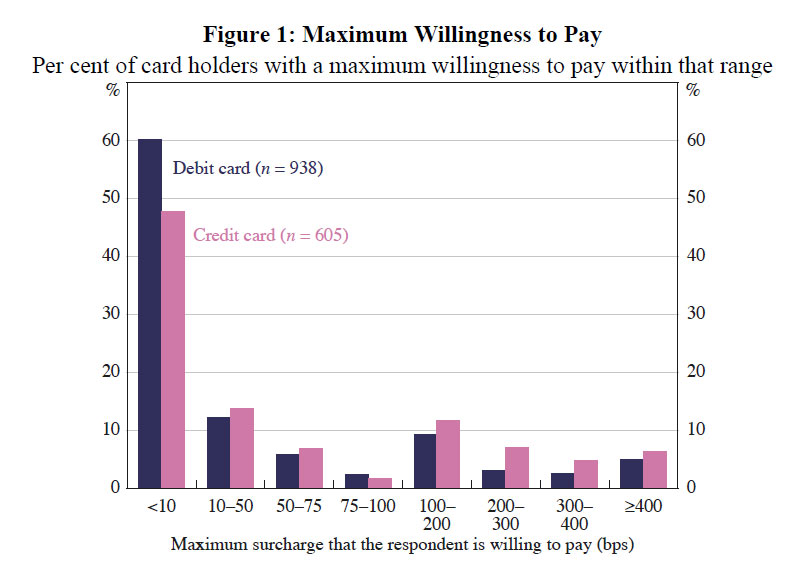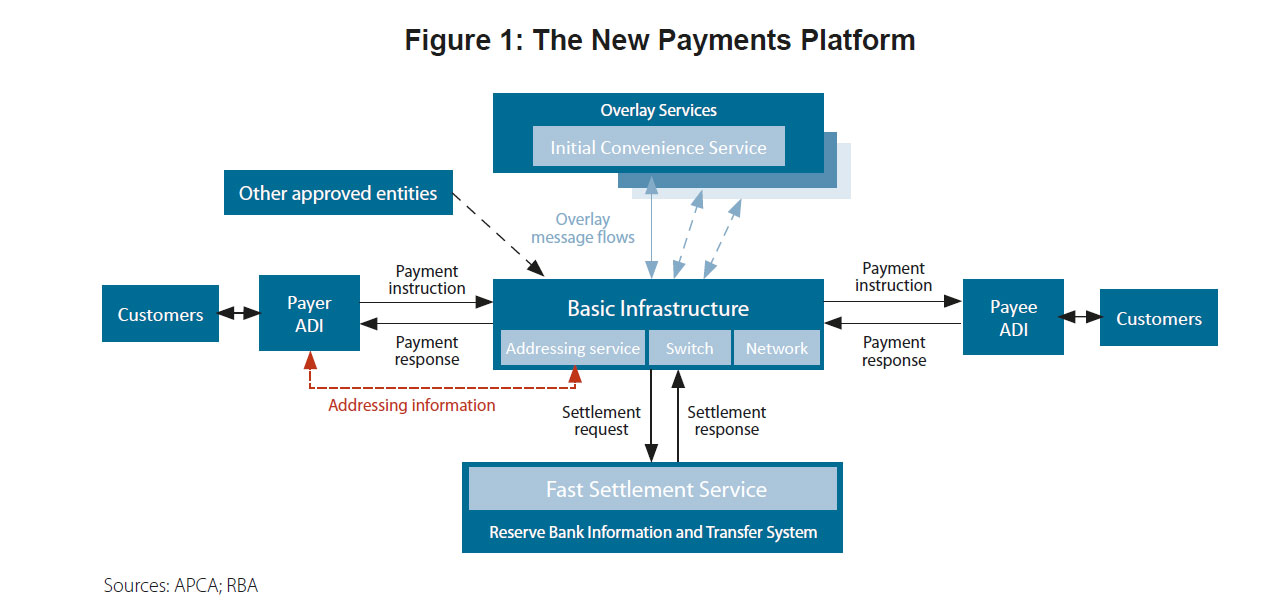The PSB more recently undertook its Strategic Review of Innovation in the Payments System, the results of which were published in 2012. That review was conducted over a two year period and involved extensive consultations with both the payments industry and with users of payments services. It found a number of areas where there was scope for system improvements that could be achieved through coordinated action.
The key areas were:
- same-day settlement of direct entry transactions;
- faster payments and out-of-hours payments to be made generally available;
- capacity for richer information with payments; and
- an easy addressing solution for electronic payments.
The first one of these was delivered at the end of 2013 and essentially involved an acceleration of existing direct entry processes. The remaining three form a more ambitious agenda and are together being taken up as part of the industry’s New Payments Platform (the NPP project).
The NPP is a successful example of what can be done through collaboration between the industry and its regulator. It is also a good example of the catalyst role for the PSB in promoting system innovation that was envisaged by Wallis. While it is an industry-led project, it is strongly supported by the PSB, and the Board continues to encourage commitment to the project and to its timely completion.
The project was launched in early 2013 and is now well advanced. On current scheduling the NPP will deliver a fast payments service with rich information and addressing capabilities in the second half of 2017. It will be linked to a fast settlement service provided by the Reserve Bank, which will allow transactions to be cleared and settled 24/7 in close to real time. All of this will amount to a world-class payments infrastructure.
It will also be a platform for further innovation. One of the key decisions made at an early stage of the project was to separate the basic clearing and settlement infrastructure from the commercially based overlay services that would use it. The industry is committed to an initial overlay that is intended to provide an attractive service and drive early volume growth. But it is important to note that access to the overlay space has always been intended to be open and competitive. Over time, this structure will allow new and specialist providers to make use of the rich capabilities provided by the core infrastructure.
Before moving on to some more detailed regulatory matters, I will mention one more initiative to have come out the 2012 Strategic Review, and that is the establishment of new industry coordination and consultation arrangements. In line with a recommendation from the 2012 Review, a new industry coordination body, the Australian Payments Council, was launched last year. The Council is a high-level body representing a diverse range of industry participants including banks, payment schemes and other service providers. It will have the capacity to give strategic direction to the industry as well as engaging in dialogue with the PSB. At the same time, it is important that the policy process engages with users and not just suppliers of payment services. To facilitate that, the Reserve Bank has also set up a Payments User Consultation Group which began meeting late last year.
In summary then, the policy work of the PSB has been very much consistent with the philosophy and objectives of the original Wallis reforms. A good deal of that work has been what might be termed ‘co-regulatory’ in nature, in the sense that it involved promoting industry-led solutions rather than using formal regulatory powers.
But of course the PSB does have a regulatory mandate, and it has used its powers to regulate a number of aspects of card payments where it judged that there was a public interest case to do so. Probably the aspects of this regulation that have attracted the most attention have been those related to interchange and surcharging, and I would like to make some general comments about each of these.
First, interchange. The commercial function of interchange fees is a very interesting one. They serve as a device for shifting the benefit-cost balance between issuers and acquirers in a four-party scheme and therefore, indirectly, between cardholders and merchants. Payment schemes argue that this can be an important competitive device that can promote innovation, for example by being structured to encourage network growth or the take-up of new products. Typically, interchange flows from the acquirer to the issuer, and hence the fee structure tends to encourage issuance and use of a card, but may discourage acceptance by merchants if the fee is too high. For mature schemes, however, the capacity of merchants to refuse acceptance may be quite limited. As a result, it has been frequently observed that competition between schemes can have the effect of pushing fees up rather than down, in order to maximise incentives to issuers and cardholders.
The reason that this kind of outcome is possible is that there is a misalignment between the incidence of these fees and the structure of decision-making power in a typical transaction. In a nutshell, the cardholder chooses the payment instrument but the merchant pays the fee.
In designing its card payment reforms, both for credit and debit, the PSB concluded that competition of this nature was distorting price signals in a way that inefficiently encouraged the use of high cost cards and added to merchant costs. Hence, it judged that there was a case for interchange fees to be capped by regulation. A number of other jurisdictions have since taken a similar view.
The second aspect that I want to talk about is surcharging. The PSB has consistently taken the view that merchants should not be prevented from surcharging for higher-cost payment methods. Scheme rules that prohibited surcharging had the effect of reinforcing the distortive effects of interchange fees by preventing costs from being passed on to cardholders. They also reduced the flexibility of merchants in deciding how to respond to high-cost payment instruments. The ability to surcharge improves merchants’ bargaining position by allowing them a greater range of responses, rather than just being faced with a binary decision to accept or reject a particular card.
Efficient surcharging should of course reflect the underlying payment cost. The PSB’s initial reforms to credit and debit gave merchants the right to surcharge, while effectively relying on competition to ensure that surcharging would not be excessive. This regulation was revised in 2013 in response to concerns about practices that had developed since the initial reforms, particularly about surcharging that appeared excessive or unrelated to costs. The amended regulation still prevents schemes from imposing no-surcharge rules, but it allows them to limit surcharging to the reasonable cost of acceptance. In doing so it strikes a balance, at least in principle, between the rights of merchants and schemes. Merchants cannot be prevented from recovering reasonable acceptance costs, but they can be prevented by scheme rules from going beyond that. More on that in a moment.
The PSB’s reforms to surcharging and interchange have formed part of a broader package that also included rules relating to access and transparency. I don’t have time to cover all of that today. But taken together, the effects have been beneficial. The system has continued to innovate, and merchants’ card payment costs have fallen.[3] It is also notable that these costs are significantly lower in Australia than in a jurisdiction like the United States, where reforms to card systems have been much more limited.
The Murray Report last year broadly endorsed the PSB’s reform approach while flagging a number of areas for further consideration, particularly in relation to surcharging and interchange. These have now been taken up as part of the PSB’s card payments review.
The issue of surcharging remains contentious. Instances of apparently excessive surcharging have persisted. While they acknowledge arguments for what might be called a ‘no excessive surcharge’ regime, the schemes have argued that the current formulation is too complicated and difficult for them to enforce.
The card payments review is looking at several possible mechanisms for addressing this. One option proposed by Murray is a tiered approach that would allow tougher surcharging constraints to be placed on low-cost cards. A number of other options are available to strengthen enforcement and disclosure practices, for example allowing schemes to cap surcharges that are not percentage based at some low fixed amount.
On interchange fee regulation there are a number of issues to consider. These include the overall level of the interchange cap, the complexity and proliferation of interchange categories, the phenomenon of interchange ‘drift’ with the three-year compliance cycle, and the wide disparity between interchange rates for preferred merchants and those applying to others.
While it broadly endorsed the PSB’s regulatory approach to date, the Murray Report recommended that consideration be given to tightening existing interchange regulations in some significant respects. These included lowering the overall interchange cap, and broadening its coverage to include other incentive payments that serve a similar function. It argued that this would help to prevent circumvention and, in the case of companion card arrangements, would improve competitive neutrality.
 Novelty and “cool factor” were driving about 43% of merchant interest in Apple Pay, the March 2015 survey of US merchant acquirers and ISOs found. By comparison, one in five said merchants’ customers were actually asking for Apple Pay. In even fewer cases were merchants pressured to keep up with the competition. Still, most respondents said relatively few merchants were interested in offering Apple Pay—over half indicated that under 10% of merchants were interested, while 28.6% put that figure between 10% and 20%.
Novelty and “cool factor” were driving about 43% of merchant interest in Apple Pay, the March 2015 survey of US merchant acquirers and ISOs found. By comparison, one in five said merchants’ customers were actually asking for Apple Pay. In even fewer cases were merchants pressured to keep up with the competition. Still, most respondents said relatively few merchants were interested in offering Apple Pay—over half indicated that under 10% of merchants were interested, while 28.6% put that figure between 10% and 20%.

